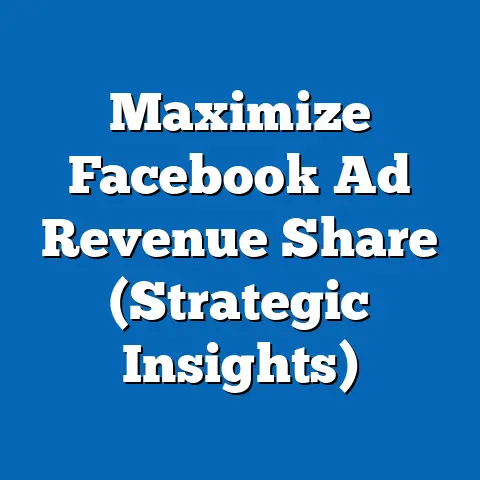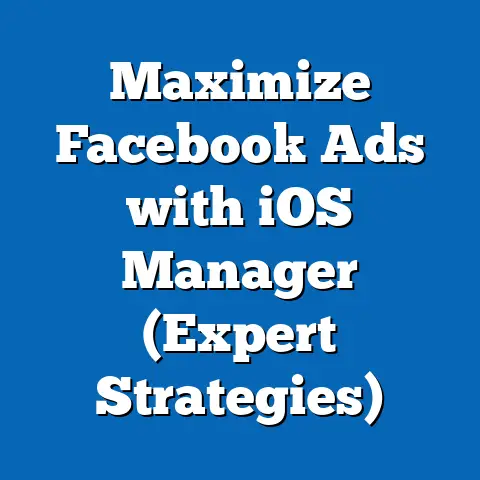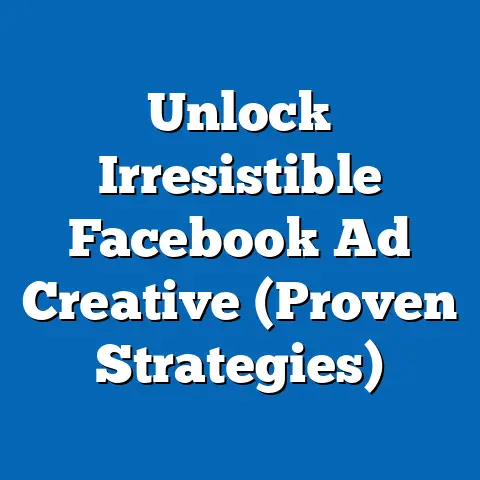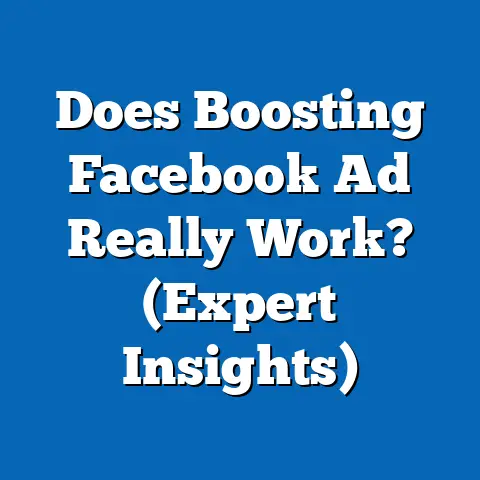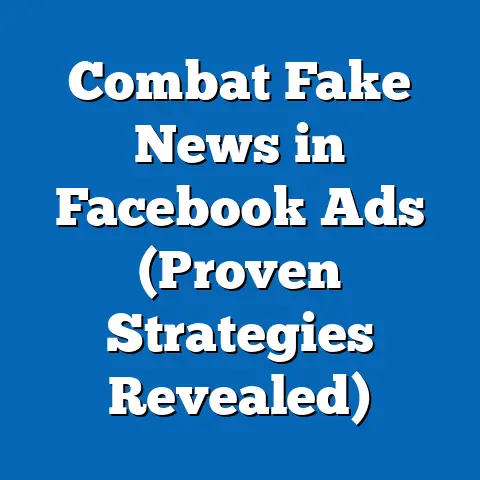Master Facebook Ads Effectiveness (Proven Strategies Inside)
Let’s face it: navigating the world of Facebook Ads is a bit like trying to teach your grandma to twerk—awkward at first, potentially embarrassing, but with the right moves, surprisingly effective. In an era where attention spans are shorter than a TikTok video, mastering the art and science of advertising on Facebook (now part of Meta’s sprawling ecosystem) is no small feat. With over 2.9 billion monthly active users as of 2023, according to Statista, Facebook remains a digital colossus, a virtual town square where businesses, big and small, vie for eyeballs and engagement.
But here’s the kicker: throwing money at ads without strategy is like shouting into the void—nobody’s listening. This article dives deep into the proven strategies that make Facebook Ads not just a gamble, but a calculated investment. We’ll explore the historical evolution of digital advertising, dissect the key characteristics that define effective campaigns, and unpack the societal implications of a world increasingly shaped by targeted marketing.
From the early days of banner ads to the hyper-personalized algorithms of today, understanding Facebook Ads is about more than just clicks and conversions—it’s about decoding human behavior in a digital age. So, buckle up as we journey through data, creativity, and cultural shifts to uncover what makes Facebook Ads tick.
Section 1: Historical Context of Digital Advertising and Facebook’s Rise
To understand the effectiveness of Facebook Ads, we must first rewind to the infancy of digital advertising. The internet’s commercial boom in the 1990s introduced the first banner ad in 1994, famously placed on HotWired.com with a simple call to action: “Have you ever clicked your mouse right here?” That ad, primitive by today’s standards, achieved a staggering 44% click-through rate (CTR), a number modern marketers can only dream of.
The introduction of the News Feed in 2006 and subsequent ad integrations transformed Facebook into a goldmine for marketers. By 2012, with the rollout of Custom Audiences, businesses could target users based on detailed demographics, interests, and behaviors—a game-changer. Today, Meta’s ad revenue, primarily from Facebook, exceeds $114 billion annually (as reported in Meta’s 2022 financials), underscoring its dominance in the digital ad space.
This historical arc isn’t just a tech story; it’s a cultural one. Facebook Ads evolved alongside societal shifts toward digital connectivity, reflecting how we’ve moved from mass media to micro-targeted messaging. The implications are profound: businesses can now speak directly to niche audiences, but this also raises ethical questions about privacy and manipulation, which we’ll explore later.
Section 2: Defining Characteristics of Effective Facebook Ads
What separates a forgettable Facebook Ad from one that stops thumbs mid-scroll? Effectiveness hinges on a blend of creativity, data-driven targeting, and adaptability to platform dynamics. Let’s break down the core characteristics that define successful campaigns, backed by research and real-world insights.
1. Precision Targeting and Audience Segmentation
Facebook’s greatest strength lies in its granular targeting capabilities. With tools like Custom Audiences, Lookalike Audiences, and Interest Targeting, advertisers can zero in on specific demographics—think “dog owners in Seattle who like craft beer.” A 2021 study by Hootsuite found that ads with hyper-specific targeting saw up to 30% higher engagement rates compared to broader campaigns.
However, it’s not just about who you target, but how well you understand their pain points and desires. Effective ads resonate emotionally, whether through humor, nostalgia, or urgency. The nuance here is critical: over-targeting can alienate users if it feels invasive, a balance marketers must strike.
2. Compelling Visuals and Copy
In a sea of content, visuals are your hook. According to Meta’s own research, ads with high-quality images or videos achieve 40% higher CTRs than text-heavy formats. Think vibrant colors, clear branding, and faces—human brains are wired to notice other humans.
Copywriting is equally vital. Short, punchy headlines (under 40 characters) paired with action-oriented calls-to-action (CTAs) like “Shop Now” or “Learn More” drive results. A/B testing, where marketers experiment with different ad variations, reveals what resonates—data from WordStream shows that ads with personalized CTAs can boost conversions by 202%.
3. Mobile Optimization
With 98.5% of Facebook users accessing the platform via mobile devices (Statista, 2023), ads must be optimized for smaller screens. Vertical videos, quick-loading images, and thumb-friendly CTAs are non-negotiable. Campaigns ignoring mobile design see drop-offs in engagement by as much as 50%, per Meta’s ad guidelines.
4. Adaptability to Algorithm Changes
Facebook’s algorithm is a moving target, prioritizing user experience over ad visibility. The 2018 shift to prioritize “meaningful interactions” over brand content forced advertisers to focus on engagement—likes, comments, and shares. Effective campaigns today leverage storytelling or interactive formats like polls to spark conversation, adapting to algorithmic whims.
These characteristics aren’t static; they evolve with user behavior and platform updates. The diversity within audiences means a one-size-fits-all approach fails—successful ads are tailored, tested, and iterated upon relentlessly.
Section 3: Proven Strategies for Maximizing Facebook Ads Effectiveness
Now that we’ve defined what makes an ad effective, let’s dive into actionable strategies grounded in data and expert insights. These aren’t just theories; they’re battle-tested methods used by top marketers to drive results.
1. Leverage the Power of Retargeting
Retargeting, or remarketing, targets users who’ve already interacted with your brand—visited your website, added items to a cart, or engaged with past ads. According to a 2022 report by Criteo, retargeted ads have a 70% higher conversion rate than initial ads. Tools like the Facebook Pixel track user behavior, enabling dynamic ads that remind users of abandoned carts or viewed products.
The key is timing and frequency. Bombarding users with ads feels spammy; spacing retargeting over 7-14 days with a cap of 3-5 impressions works best. This strategy taps into familiarity without crossing into annoyance.
2. Harness Video Content for Engagement
Video ads dominate Facebook, with users spending 3x longer watching videos than static content (Meta, 2021). Short-form videos (15-30 seconds) with captions—since 85% of videos are watched on mute—capture attention fast. Storytelling, tutorials, or behind-the-scenes content humanizes brands, fostering trust.
Take the example of Dollar Shave Club, whose humorous video ads on Facebook in the early 2010s went viral, driving millions in sales. The lesson? Emotion and entertainment trump hard sells.
3. Optimize for Conversions, Not Just Clicks
While clicks are nice, conversions—sales, sign-ups, or downloads—are the endgame. Using Facebook’s Campaign Budget Optimization (CBO), advertisers allocate budgets across ad sets to maximize results. Landing pages must align with ad messaging; a 2020 Unbounce study found that mismatched ads and landing pages drop conversion rates by 40%.
Conversion tracking via the Facebook Pixel provides data on what’s working. Focus on Cost Per Acquisition (CPA) over Cost Per Click (CPC)—spending $1 per click means little if it doesn’t translate to revenue.
4. Test, Analyze, and Iterate
The mantra of digital advertising is “test everything.” A/B testing different headlines, images, and audiences uncovers winning combinations. Facebook’s Ad Manager offers robust analytics on impressions, reach, and engagement, guiding data-driven decisions. Experts like Jon Loomer advocate for testing small budgets ($5-10 per ad set) before scaling winners.
Iteration is ongoing. Consumer trends shift, and so must ads—seasonal campaigns, cultural references, or new product launches keep content fresh.
5. Utilize User-Generated Content (UGC)
UGC—reviews, testimonials, or customer photos—builds authenticity. Ads featuring real users see 35% higher engagement, per Stackla’s 2021 survey. Encouraging customers to share experiences (with incentives like discounts) creates a feedback loop of trust and visibility.
These strategies aren’t isolated; they work best in tandem. A retargeted video ad with UGC, optimized for mobile, and tested rigorously, exemplifies the multi-layered approach needed for success.
Section 4: Societal Implications of Facebook Ads
The effectiveness of Facebook Ads extends beyond marketing metrics; it shapes societal norms, economic structures, and cultural perceptions. This dual-edged sword warrants a closer look at its broader impacts.
1. Economic Democratization vs. Market Saturation
Facebook Ads have democratized advertising, allowing small businesses and solopreneurs to compete with corporate giants. With budgets as low as $1 per day, anyone can reach a global audience—a stark contrast to traditional media’s high entry barriers. A 2022 Meta report claimed that 10 million advertisers, many small-scale, use the platform, driving local economies.
Yet, this accessibility breeds saturation. With millions of ads vying for attention, standing out requires ever-increasing budgets or creativity, potentially widening gaps between savvy marketers and novices. The economic playing field is leveled, but not entirely flat.
2. Cultural Influence and Consumer Behavior
Facebook Ads don’t just reflect culture; they shape it. Targeted campaigns amplify trends—think fitness fads or sustainable products—by curating what users see. A 2019 study by the University of Southern California found that social media ads influence 60% of Gen Z’s purchasing decisions, illustrating their role in cultural curation.
This influence isn’t always benign. Ads can perpetuate materialism or unrealistic standards (e.g., beauty filters), sparking debates on mental health. The diversity within generations means not all react uniformly—older users may resist, while younger ones embrace trends, highlighting varied societal impacts.
3. Privacy and Ethical Concerns
The backbone of Facebook Ads—user data—raises ethical red flags. The 2018 Cambridge Analytica scandal, where data was misused for political ads, exposed vulnerabilities in privacy practices. While Meta has since tightened policies, a 2023 Pew Research survey found 70% of Americans remain skeptical of data usage in advertising.
Targeted ads can feel like mind-reading, unnerving users when they’re too accurate. Societally, this fuels distrust in tech giants and calls for regulation, as seen with the EU’s GDPR laws. Balancing effectiveness with ethics is a tightrope marketers must walk.
4. Workplace and Industry Shifts
The rise of Facebook Ads has birthed new careers—digital marketers, ad specialists, and content creators—reshaping the job market. Companies now prioritize digital presence, with 80% of businesses increasing social media ad budgets post-2020, per HubSpot. This shift demands tech-savvy workforces, influencing education and training trends.
However, reliance on algorithms can deskill traditional marketing roles, prioritizing data over creativity. The societal ripple effect is a workforce in flux, adapting to a digital-first economy.
Section 5: Technological and Algorithmic Influences on Ad Effectiveness
Technology underpins every aspect of Facebook Ads, from creation to delivery. Understanding these mechanisms is crucial for effectiveness.
1. The Role of AI and Machine Learning
Facebook’s ad delivery system relies heavily on machine learning to predict user behavior. The algorithm analyzes thousands of data points—past clicks, time spent on content, device type—to serve relevant ads. A 2021 Meta blog post revealed that AI-driven optimization boosts ad performance by up to 25%.
This tech isn’t foolproof. Algorithm biases can skew targeting (e.g., gender stereotypes in job ads), necessitating human oversight. Marketers must stay updated on AI tools while advocating for fairness.
2. Impact of Platform Updates
Apple’s iOS 14 update in 2021, with its App Tracking Transparency (ATT) feature, disrupted Facebook’s tracking capabilities, costing Meta an estimated $10 billion in ad revenue (Forbes, 2022). Advertisers adapted by focusing on first-party data and in-platform metrics.
Such updates highlight the fragility of reliance on third-party tech. Effective campaigns diversify tracking methods and prioritize organic engagement alongside paid ads.
3. Emerging Formats and Features
Innovations like Facebook Reels and Shops integrate ads seamlessly into user experiences. Interactive formats—carousels, instant experiences—boost engagement by 20%, per Meta’s data. Staying ahead of these trends is non-negotiable for relevance.
Technology is both an enabler and a challenge. Marketers must harness it without being overly dependent, a balance that defines modern advertising.
Section 6: Comparing Effectiveness Across Generations
Generational differences play a significant role in ad effectiveness, as values, tech adoption, and cultural context vary widely. Let’s compare responses without resorting to stereotypes, focusing on data-driven insights.
1. Baby Boomers (Born 1946-1964)
Boomers, often less tech-native, use Facebook primarily for social connection—59% are active users (Pew Research, 2022). They respond well to nostalgic content and straightforward CTAs, with trust in brands a key driver. Ads for health, travel, or family-oriented products resonate, though over-complex formats may deter engagement.
2. Generation X (Born 1965-1980)
Gen X, the “forgotten middle,” bridges analog and digital worlds. They value authenticity and are skeptical of hard sells, per a 2021 Nielsen report. Ads with practical benefits—discounts, reviews—work best, often for home goods or financial services. Engagement rates are steady but lower than younger cohorts.
3. Millennials (Born 1981-1996)
Millennials, digital natives, are 75% active on Facebook (Statista, 2023), though many shift to Instagram. They prioritize social responsibility—ads from ethical brands see 30% higher click-throughs (Hootsuite, 2020). Video and experiential content (e.g., contests) drive engagement, reflecting their value of connection.
4. Generation Z (Born 1997-2012)
Gen Z, the mobile-first generation, spends less time on Facebook but engages with short, trendy content like Reels. Authenticity and humor are paramount—UGC and influencer collabs boost trust by 50% (Stackla, 2021). Their skepticism of traditional ads demands creativity over polish.
These differences aren’t rigid; income, location, and personal interests add layers of complexity. Tailoring ads by generation while testing cross-demographic appeal maximizes reach.
Section 7: Forward-Looking Insights and Uncertainties
As we look to the future, the landscape of Facebook Ads is both promising and unpredictable. Emerging technologies like augmented reality (AR) ads and the metaverse offer immersive opportunities—Meta’s Horizon Worlds hints at virtual storefronts where ads blend into 3D experiences. A 2023 Deloitte report predicts AR-driven ads could generate $50 billion by 2025.
Yet, uncertainties loom. Regulatory pressures, like potential antitrust actions against Meta, could reshape data practices, impacting targeting precision. User fatigue—evidenced by declining organic reach—pushes advertisers toward paid strategies, but at what cost to authenticity?
Economic factors, such as inflation or recession, may shrink ad budgets, forcing leaner, more creative campaigns. Meanwhile, generational shifts—Gen Alpha’s rise—will demand new approaches to engagement, likely centered on interactivity and gamification.
The societal implications are vast. Will hyper-targeted ads deepen cultural divides by reinforcing echo chambers? Or can they foster inclusivity through diverse representation? These questions remain open, but one certainty stands: adaptability is the cornerstone of future success.
Conclusion: Mastering the Art and Science of Facebook Ads
Mastering Facebook Ads is a dynamic pursuit, blending art, science, and a dash of humor to navigate the digital dance of attention. From their historical roots in early internet marketing to today’s AI-driven precision, these ads reflect broader societal shifts—economic democratization, cultural influence, and ethical dilemmas. Proven strategies like retargeting, video content, and relentless testing offer a roadmap to effectiveness, but success demands an understanding of technology, generational nuances, and evolving user expectations.
The implications extend far beyond marketing. Facebook Ads shape how we consume, connect, and perceive the world, influencing workplaces, economies, and personal values. As we move forward, balancing innovation with responsibility will be key—ensuring ads enhance, rather than exploit, the human experience.
So, whether you’re a small business owner or a corporate marketer, remember: a great Facebook Ad isn’t just seen; it’s felt. Keep testing, keep adapting, and maybe, just maybe, you’ll teach the algorithm to twerk in your favor.

